Aarti Singh
Carnegie Mellon University
Transformers Provably Learn Chain-of-Thought Reasoning with Length Generalization
Nov 10, 2025Abstract:The ability to reason lies at the core of artificial intelligence (AI), and challenging problems usually call for deeper and longer reasoning to tackle. A crucial question about AI reasoning is whether models can extrapolate learned reasoning patterns to solve harder tasks with longer chain-of-thought (CoT). In this work, we present a theoretical analysis of transformers learning on synthetic state-tracking tasks with gradient descent. We mathematically prove how the algebraic structure of state-tracking problems governs the degree of extrapolation of the learned CoT. Specifically, our theory characterizes the length generalization of transformers through the mechanism of attention concentration, linking the retrieval robustness of the attention layer to the state-tracking task structure of long-context reasoning. Moreover, for transformers with limited reasoning length, we prove that a recursive self-training scheme can progressively extend the range of solvable problem lengths. To our knowledge, we provide the first optimization guarantee that constant-depth transformers provably learn $\mathsf{NC}^1$-complete problems with CoT, significantly going beyond prior art confined in $\mathsf{TC}^0$, unless the widely held conjecture $\mathsf{TC}^0 \neq \mathsf{NC}^1$ fails. Finally, we present a broad set of experiments supporting our theoretical results, confirming the length generalization behaviors and the mechanism of attention concentration.
OEUVRE: OnlinE Unbiased Variance-Reduced loss Estimation
Oct 26, 2025Abstract:Online learning algorithms continually update their models as data arrive, making it essential to accurately estimate the expected loss at the current time step. The prequential method is an effective estimation approach which can be practically deployed in various ways. However, theoretical guarantees have previously been established under strong conditions on the algorithm, and practical algorithms have hyperparameters which require careful tuning. We introduce OEUVRE, an estimator that evaluates each incoming sample on the function learned at the current and previous time steps, recursively updating the loss estimate in constant time and memory. We use algorithmic stability, a property satisfied by many popular online learners, for optimal updates and prove consistency, convergence rates, and concentration bounds for our estimator. We design a method to adaptively tune OEUVRE's hyperparameters and test it across diverse online and stochastic tasks. We observe that OEUVRE matches or outperforms other estimators even when their hyperparameters are tuned with oracle access to ground truth.
Projection Optimization: A General Framework for Multi-Objective and Multi-Group RLHF
Feb 24, 2025Abstract:Reinforcement Learning with Human Feedback (RLHF) is a widely used fine-tuning approach that aligns machine learning model, particularly Language Model (LM) with human preferences. There are typically multiple objectives driving the preference, hence humans find it easier to express per-objective comparisons rather than a global preference between two choices. Multi-Objective RLHF (MORLHF) aims to use per-objective preference feedback and achieve Pareto optimality among these objectives by aggregating them into a single unified objective for optimization. However, nearly all prior works rely on linear aggregation, which rules out policies that favor specific objectives such as the worst one. The only existing approach using non-linear aggregation is computationally expensive due to its reward-based nature and the need for retraining whenever the aggregation parameters change. In this work, we address this limitation by transforming the non-linear aggregation maximization problem into a series of sub-problems. Each sub-problem involves only linear aggregation, making it computationally efficient to solve. We further extend our framework to handle multi-group scenarios, where each group has distinct weights for the objectives. Our method enables achieving consensus or maximizing the aggregated objective across all groups. Theoretically, we demonstrate that our algorithmic framework achieves sublinear regret and can be easily adapted to a reward-free algorithm. Empirically, leveraging our theoretical insights, we propose a nearly training-free algorithm once the optimal policies for individual objectives are obtained.
Optimistic Algorithms for Adaptive Estimation of the Average Treatment Effect
Feb 07, 2025Abstract:Estimation and inference for the Average Treatment Effect (ATE) is a cornerstone of causal inference and often serves as the foundation for developing procedures for more complicated settings. Although traditionally analyzed in a batch setting, recent advances in martingale theory have paved the way for adaptive methods that can enhance the power of downstream inference. Despite these advances, progress in understanding and developing adaptive algorithms remains in its early stages. Existing work either focus on asymptotic analyses that overlook exploration-exploitation tradeoffs relevant in finite-sample regimes or rely on simpler but suboptimal estimators. In this work, we address these limitations by studying adaptive sampling procedures that take advantage of the asymptotically optimal Augmented Inverse Probability Weighting (AIPW) estimator. Our analysis uncovers challenges obscured by asymptotic approaches and introduces a novel algorithmic design principle reminiscent of optimism in multiarmed bandits. This principled approach enables our algorithm to achieve significant theoretical and empirical gains compared to prior methods. Our findings mark a step forward in advancing adaptive causal inference methods in theory and practice.
Logarithmic Neyman Regret for Adaptive Estimation of the Average Treatment Effect
Nov 21, 2024Abstract:Estimation of the Average Treatment Effect (ATE) is a core problem in causal inference with strong connections to Off-Policy Evaluation in Reinforcement Learning. This paper considers the problem of adaptively selecting the treatment allocation probability in order to improve estimation of the ATE. The majority of prior work on adaptive ATE estimation focus on asymptotic guarantees, and in turn overlooks important practical considerations such as the difficulty of learning the optimal treatment allocation as well as hyper-parameter selection. Existing non-asymptotic methods are limited by poor empirical performance and exponential scaling of the Neyman regret with respect to problem parameters. In order to address these gaps, we propose and analyze the Clipped Second Moment Tracking (ClipSMT) algorithm, a variant of an existing algorithm with strong asymptotic optimality guarantees, and provide finite sample bounds on its Neyman regret. Our analysis shows that ClipSMT achieves exponential improvements in Neyman regret on two fronts: improving the dependence on $T$ from $O(\sqrt{T})$ to $O(\log T)$, as well as reducing the exponential dependence on problem parameters to a polynomial dependence. Finally, we conclude with simulations which show the marked improvement of ClipSMT over existing approaches.
Beyond Parameter Count: Implicit Bias in Soft Mixture of Experts
Sep 02, 2024



Abstract:The traditional viewpoint on Sparse Mixture of Experts (MoE) models is that instead of training a single large expert, which is computationally expensive, we can train many small experts. The hope is that if the total parameter count of the small experts equals that of the singular large expert, then we retain the representation power of the large expert while gaining computational tractability and promoting expert specialization. The recently introduced Soft MoE replaces the Sparse MoE's discrete routing mechanism with a differentiable gating function that smoothly mixes tokens. While this smooth gating function successfully mitigates the various training instabilities associated with Sparse MoE, it is unclear whether it induces implicit biases that affect Soft MoE's representation power or potential for expert specialization. We prove that Soft MoE with a single arbitrarily powerful expert cannot represent simple convex functions. This justifies that Soft MoE's success cannot be explained by the traditional viewpoint of many small experts collectively mimicking the representation power of a single large expert, and that multiple experts are actually necessary to achieve good representation power (even for a fixed total parameter count). Continuing along this line of investigation, we introduce a notion of expert specialization for Soft MoE, and while varying the number of experts yet fixing the total parameter count, we consider the following (computationally intractable) task. Given any input, how can we discover the expert subset that is specialized to predict this input's label? We empirically show that when there are many small experts, the architecture is implicitly biased in a fashion that allows us to efficiently approximate the specialized expert subset. Our method can be easily implemented to potentially reduce computation during inference.
Hybrid Reinforcement Learning from Offline Observation Alone
Jun 11, 2024
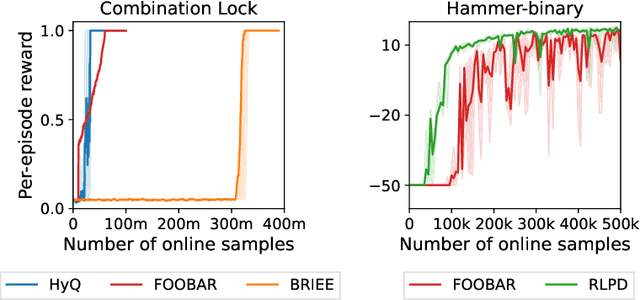

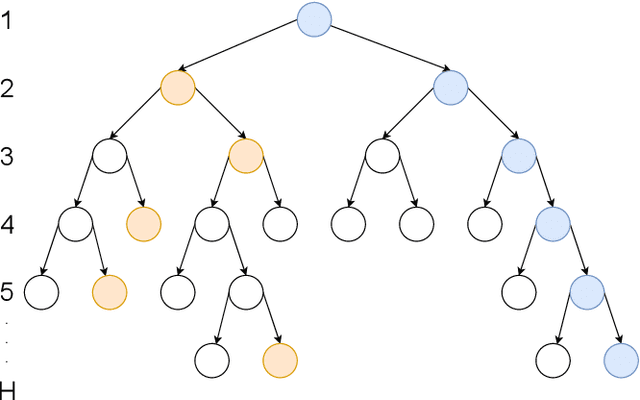
Abstract:We consider the hybrid reinforcement learning setting where the agent has access to both offline data and online interactive access. While Reinforcement Learning (RL) research typically assumes offline data contains complete action, reward and transition information, datasets with only state information (also known as observation-only datasets) are more general, abundant and practical. This motivates our study of the hybrid RL with observation-only offline dataset framework. While the task of competing with the best policy "covered" by the offline data can be solved if a reset model of the environment is provided (i.e., one that can be reset to any state), we show evidence of hardness when only given the weaker trace model (i.e., one can only reset to the initial states and must produce full traces through the environment), without further assumption of admissibility of the offline data. Under the admissibility assumptions -- that the offline data could actually be produced by the policy class we consider -- we propose the first algorithm in the trace model setting that provably matches the performance of algorithms that leverage a reset model. We also perform proof-of-concept experiments that suggest the effectiveness of our algorithm in practice.
Understanding Preference Fine-Tuning Through the Lens of Coverage
Jun 03, 2024
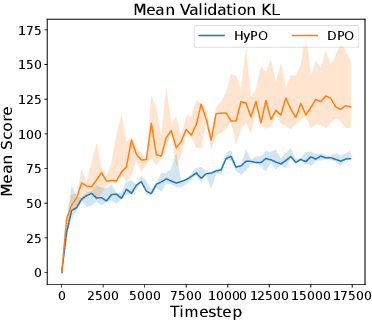


Abstract:Learning from human preference data has emerged as the dominant paradigm for fine-tuning large language models (LLMs). The two most common families of techniques -- online reinforcement learning (RL) such as Proximal Policy Optimization (PPO) and offline contrastive methods such as Direct Preference Optimization (DPO) -- were positioned as equivalent in prior work due to the fact that both have to start from the same offline preference dataset. To further expand our theoretical understanding of the similarities and differences between online and offline techniques for preference fine-tuning, we conduct a rigorous analysis through the lens of dataset coverage, a concept that captures how the training data covers the test distribution and is widely used in RL. We prove that a global coverage condition is both necessary and sufficient for offline contrastive methods to converge to the optimal policy, but a weaker partial coverage condition suffices for online RL methods. This separation provides one explanation of why online RL methods can perform better than offline methods, especially when the offline preference data is not diverse enough. Finally, motivated by our preceding theoretical observations, we derive a hybrid preference optimization (HyPO) algorithm that uses offline data for contrastive-based preference optimization and online data for KL regularization. Theoretically and empirically, we demonstrate that HyPO is more performant than its pure offline counterpart DPO, while still preserving its computation and memory efficiency.
Learning Social Welfare Functions
May 27, 2024



Abstract:Is it possible to understand or imitate a policy maker's rationale by looking at past decisions they made? We formalize this question as the problem of learning social welfare functions belonging to the well-studied family of power mean functions. We focus on two learning tasks; in the first, the input is vectors of utilities of an action (decision or policy) for individuals in a group and their associated social welfare as judged by a policy maker, whereas in the second, the input is pairwise comparisons between the welfares associated with a given pair of utility vectors. We show that power mean functions are learnable with polynomial sample complexity in both cases, even if the comparisons are social welfare information is noisy. Finally, we design practical algorithms for these tasks and evaluate their performance.
Role of Locality and Weight Sharing in Image-Based Tasks: A Sample Complexity Separation between CNNs, LCNs, and FCNs
Mar 23, 2024
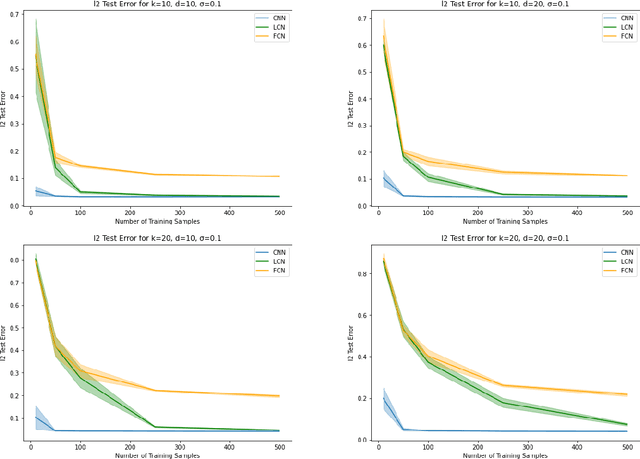
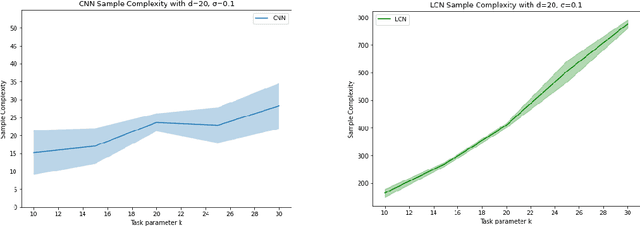
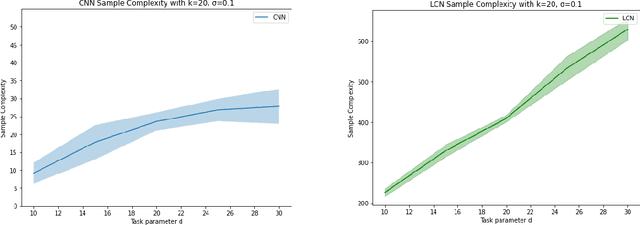
Abstract:Vision tasks are characterized by the properties of locality and translation invariance. The superior performance of convolutional neural networks (CNNs) on these tasks is widely attributed to the inductive bias of locality and weight sharing baked into their architecture. Existing attempts to quantify the statistical benefits of these biases in CNNs over locally connected convolutional neural networks (LCNs) and fully connected neural networks (FCNs) fall into one of the following categories: either they disregard the optimizer and only provide uniform convergence upper bounds with no separating lower bounds, or they consider simplistic tasks that do not truly mirror the locality and translation invariance as found in real-world vision tasks. To address these deficiencies, we introduce the Dynamic Signal Distribution (DSD) classification task that models an image as consisting of $k$ patches, each of dimension $d$, and the label is determined by a $d$-sparse signal vector that can freely appear in any one of the $k$ patches. On this task, for any orthogonally equivariant algorithm like gradient descent, we prove that CNNs require $\tilde{O}(k+d)$ samples, whereas LCNs require $\Omega(kd)$ samples, establishing the statistical advantages of weight sharing in translation invariant tasks. Furthermore, LCNs need $\tilde{O}(k(k+d))$ samples, compared to $\Omega(k^2d)$ samples for FCNs, showcasing the benefits of locality in local tasks. Additionally, we develop information theoretic tools for analyzing randomized algorithms, which may be of interest for statistical research.
 Add to Chrome
Add to Chrome Add to Firefox
Add to Firefox Add to Edge
Add to Edge